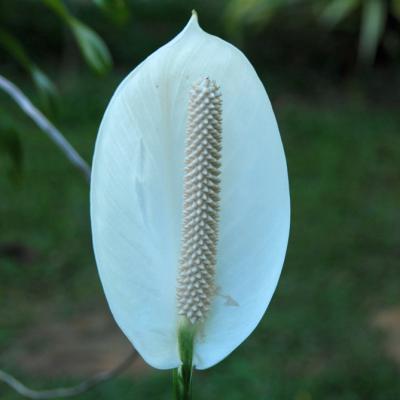Araceae-Spathiphyllum-wallisii
Classification
- Botanical Family : Araceae
- Genus : Spathiphyllum
- Epithet : wallisii
- German Family Name: Aronstabgewächse
- English Name: Peace lily, White sails
- Thai Name: เดหลี เดหลีใบกล้วย
- Thai Phonetic: deli; deli bai gluai
- Author: Regel
- Height: 1.00
Water Requirements
Plant Type
Light Requirements
Cultivation
Spathiphyllum wallisii in tropical gardens is a very common plants. She has beautiful foliages. The long-lasting, white flowers stand erect and extend beyond the leaves. The flower has a typical shape for aroids. The spadix is usually cream or ivory colored when it is young. It is green with age. The spathe is usually white or white with green nerves, it also turns green with age. The leaves are glossy and dark green. It blooms from March to August.
Spathiphyllum wallisii is easy to take care. The plant needs a bright shade or a partial shade place out of direct sunlight. It should be regularly watered very well, but the soil should be dry between each watering, otherwise reduced flowering.
Propagation: by dividing the rootstock.
The species name wallisii is derived from the German botanist Gustav Wallis.
The juice of this plant is poisonous. It causes skin irritation in contact with skin. If consumed the raw parts of the plant it causes irritation in the mouth, lips, throat and tongue.
Der Saft dieser Pflanze ist giftig. Er verursacht bei Hautkontakt Hautreizungen. Bei Einnahme bewirkt er Reizungen im Mund, auf Lippen, im Rachen und auf der Zunge.
Origin
Miscelaneous
Spathophyllum wallisii is capable of air pollution such as Formaldehyde to filter out from the air. As an indoor pot plant helps Spathophyllum wallisii to clean the air. (1)
(1) http://www.nytimes.com/1994/02/13/nyregion/cuttings-need-an-air-freshener-try-plants.html?sec=&spon=&pagewanted=all
Spathophyllum wallisii ist in der Lage, Raumgifte wie z.B. Formaldehyd aus der Luft heraus zu filtern. Als Topfpflanze im Zimmer gahalten, dient sie somit auch der Luftverbesserung. (1)
(1) http://www.nytimes.com/1994/02/13/nyregion/cuttings-need-an-air-freshener-try-plants.html?sec=&spon=&pagewanted=all


